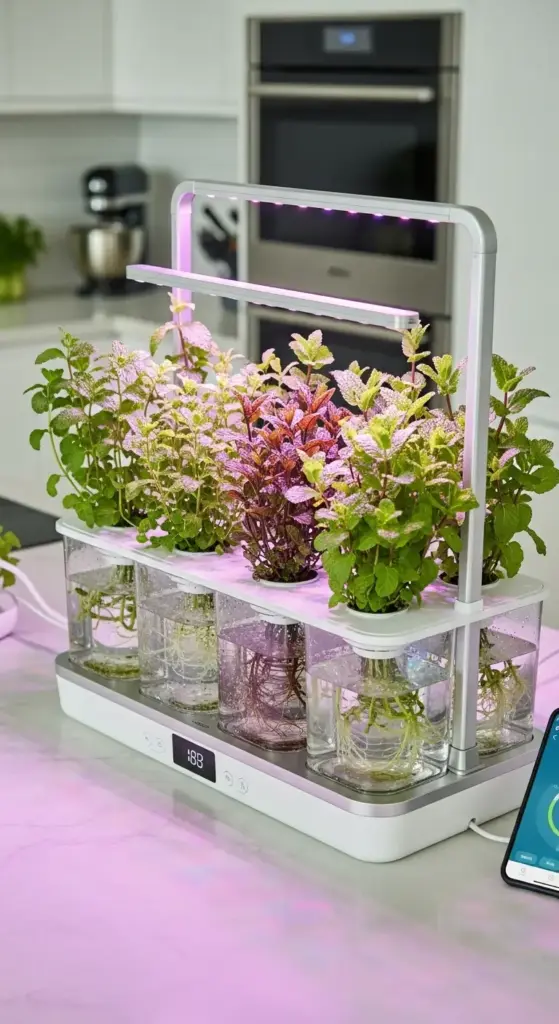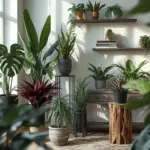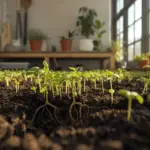7. Modern Hydroponic Systems for Mint Medleys

My journey into hydroponic systems started when I got tired of mint taking over every single pot I planted it in. Traditional soil gardening with mint is like inviting a party guest who never leaves – it just spreads everywhere and crowds out everything else.
That first countertop hydroponic unit changed everything. Suddenly I had control over my mint’s aggressive tendencies while getting the most incredible harvests I’d ever seen.
High-Tech Solutions That Actually Work
Modern home chef technology has come so far that growing herbs hydroponically is easier than maintaining a traditional herb garden. I was skeptical at first – seemed too good to be true – but the results speak for themselves.
Smart hydroponic systems monitor everything automatically – pH levels, nutrient concentrations, water levels, even lighting schedules. It’s like having a personal gardener who never takes a day off.
Aerogarden systems are perfect for beginners because they’re basically foolproof. I started with their basic model and quickly upgraded to the larger units once I saw how fast my mint varieties were growing.
The LED grow lights in modern systems are specifically tuned for optimal plant growth. No more guessing about whether your herbs are getting enough light – these systems deliver exactly what each plant needs.
Water circulation in quality hydroponic units prevents the stagnation issues that can kill traditional potted mint. The constant gentle movement keeps roots healthy and oxygenated.
The space efficiency is incredible compared to traditional pots. I can grow six different mint varieties in the same counter space that used to hold two ceramic planters.
Mint Variety Selection That Makes Sense
Spearmint is my go-to variety for hydroponic growing because it’s vigorous without being completely aggressive. The classic mint flavor works in everything from mojitos to Middle Eastern dishes.
Peppermint grows like crazy in hydroponic systems – almost too well if you’re not careful about pruning. The intense menthol flavor is perfect for teas and dessert applications.
Chocolate mint is the conversation starter of my hydroponic garden. Guests always do a double-take when they smell the leaves – it literally smells like chocolate and mint combined.
Apple mint has this subtle fruity undertone that’s incredible in summer drinks and fruit salads. It’s less aggressive than other varieties, making it perfect for shared hydroponic systems.
Pineapple mint with its variegated leaves adds visual interest to hydroponic displays. The flavor is mild and sweet – great for garnishing desserts or infusing simple syrups.
Orange mint brings citrusy notes that work amazingly well in both sweet and savory applications. I use it in marinades for chicken and in fruit-forward cocktails.
Smart Home Integration Magic
Kitchen technology integration with hydroponic systems is where things get really exciting. I can monitor and control my mint garden from my phone while I’m at the grocery store.
WiFi-enabled systems send alerts when water levels are low or when it’s time to add nutrients. No more dead herbs because I forgot to check on them for a week.
Voice control through Alexa or Google Home lets me check on my herbs while I’m cooking. “Hey Google, how’s my mint garden doing?” gets me real-time status updates.
Smart scheduling adjusts lighting and nutrient cycles based on the specific growth stage of each plant. The system learns and optimizes automatically – it’s honestly smarter than I am about plant care.
Integration with recipe apps is my favorite feature. The system can suggest which herbs to harvest based on what I’m planning to cook that week.
Automated nutrient dosing takes the guesswork out of feeding your plants. The system calculates exactly what each variety needs and delivers it precisely.
Containing Mint’s Aggressive Nature
Preventing mint takeover in shared hydroponic systems requires strategic planning that I learned through some expensive mistakes. Mint’s root system can dominate if you’re not careful.
Physical barriers within the growing medium help contain each variety’s root zone. I use small mesh dividers that allow water circulation but prevent root mixing.
Separate growing pods for each mint variety work best in larger systems. This gives you complete control over each plant’s environment while preventing cross-contamination.
Regular root pruning is essential with mint in hydroponic systems. I trim back the root systems monthly to prevent any one variety from overwhelming the others.
Harvest frequency affects how aggressively mint spreads. The more you harvest, the more energy the plant puts into leaf production rather than root expansion.
Nutrient management can influence growth patterns too. Lower nitrogen levels slow down the aggressive spreading while still maintaining healthy leaf production.
Creative Culinary Applications
Fresh mint cocktails are where hydroponic growing really shines because you always have perfect, pesticide-free leaves ready for muddling. The flavor intensity of hydroponically grown mint is incredible.
Mojitos with chocolate mint blow people’s minds at dinner parties. The subtle chocolate undertone adds complexity that regular spearmint just can’t match.
Mint simple syrups made from different varieties create a whole arsenal of cocktail ingredients. I keep peppermint, spearmint, and apple mint syrups in my fridge year-round.
Savory applications for fresh mint are endless – lamb dishes, Middle Eastern salads, Vietnamese spring rolls. Having multiple varieties lets you match the mint to the cuisine perfectly.
Mint oils and vinegars are easy to make when you have consistent harvests from hydroponic systems. I infuse olive oil with chocolate mint for drizzling over desserts.
Ice cubes with mint leaves frozen inside are gorgeous in summer drinks. The hydroponic mint stays fresh-looking longer than soil-grown varieties.
Mint tea blends using different varieties create custom flavors you can’t buy anywhere. Peppermint and apple mint together makes this amazing digestive tea.
Dessert garnishes with fresh mint elevate even simple desserts to restaurant quality. The clean, intense flavors from hydroponic growing make every dish look and taste professional.
Preservation techniques for hydroponic mint work better than traditional methods because the leaves are cleaner and more uniform. I freeze whole leaves in ice cube trays with a little water for perfect portion control.
Mint pest control is practically non-existent with hydroponic systems. No soil means no soil-borne pests, and the controlled environment prevents most common herb garden problems.
The year-round availability of fresh mint varieties has completely changed how I cook and entertain. There’s something magical about snipping fresh chocolate mint for hot chocolate in December or having perfect spearmint for summer cocktails in January.
Conclusion
These seven indoor herb pot ideas prove that you don’t need a Michelin star to grow like a master chef! Each option offers unique benefits for the modern home gardener who values both functionality and style.
From the temperature-regulating properties of marble to the rustic charm of reclaimed wood, there’s a perfect solution for every kitchen aesthetic and gardening skill level.
The key is choosing containers that not only support healthy plant growth but also complement your personal style and home decor vision.
Start with one or two herb varieties that you use most frequently in your cooking, then expand your indoor garden as your confidence grows.
Your future dinner guests will be amazed by the fresh, restaurant-quality flavors you’ll bring to every meal.
Which herb pot idea will you try first in your culinary garden adventure?









GIPHY App Key not set. Please check settings